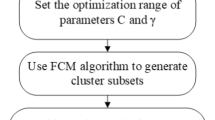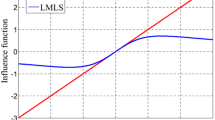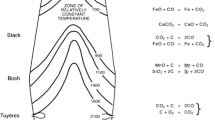Abstract
Silicon content prediction is quite significant for supervising the state of blast furnace and is usually selected as the indicator to represent the thermal state. In practical industry, the fluctuation exists in the operation of blast furnace all the time. What’s worse, it is inaccurate to build the predictive model with many outliers. To solve these problems, this paper has developed a model to predict the silicon content using support vector regression (SVR) combined with clustering algorithms, including hard C-means (HCM) clustering and fuzzy C-means (FCM) clustering. Through data processing, the data points are clustered based on the similarity, and then different SVR models are established. In order to make full use of FCM, a new method using multiple SVRs and FCM based on membership degree (MFCM-SVRs) is proposed where the membership degree is applied to eliminate the outliers. Simulation results verify that the multiple SVRs based on HCM (HCM-SVRs) and MFCM-SVRs possess superiority in terms of accuracy and speed, which makes the method serve better for practical production.









Similar content being viewed by others
References
Jindal A, Pujari S, Sandilya P, Ganguly S (2007) A reduced order thermo-chemical model for blast furnace for real time simulation. Comput Chem Eng 31(11):1484–1495
Su HY, Zeng JS, Gao CH (2010) Data-driven predictive control for blast furnace ironmaking process. Comput Chem Eng 34(11):1854–1862
Jian L, Gao CH, Ge QH (2014) Rule extraction from fuzzy based blast furnace SVM multiclassifier for decision-making. IEEE Trans Fuzzy Syst 22(3):586–596
Du SW, Cheng WT, Huang EN (2014) Numerical analysis on transient thermal flow of the blast furnace hearth in tapping process through CFD. Int J Heat Mass Transf 57:13–21
Zhang Y, Rohit D, Huang D, Pinakin C, Zhou CQ (2008) Numerical analysis of blast furnace hearth inner profile by using CFD and heat transfer model for different time periods. Int J Heat Mass Transf 51(1–2):186–197
Das SK, Kumari A, Bandopadhay D, Akbar SA, Mondal GK (2011) A mathematical model to characterise effects of liquid hold-up on bosh silicon transport in the dripping zone of a blast furnace. Appl Math Model 35(9):4208–4221
Chen J (2001) A predictive system for blast furnaces by integrating a neural network with qualitative analysis. Eng Appl Artif Intell 14(1):77–85
Yang YL, Zhang S, Yin YX (2016) A modified ELM algorithm for the prediction of silicon content in hot metal. Neural Comput Appl 27(1):241–247
Yu T, Li JP, Shi L, Li ZL (2011) Model of hot metal silicon content in blast furnace based on principal component analysis application and partial least square. J Iron Steel Res Int 18(10):13–16
Wang WH, Liu XY, Wang YK (2007) Prediction of silicon content in hot metal based on Bayesian network. In: Third international conference on natural computation, Haikou, China, vol 5, pp 446–450
Luo SH, Gao CH, Jian L (2012) Modeling of the thermal state change of blast furnace hearth with support vector machines. IEEE Trans Ind Electron 59(2):1134–1145
Gao CH, Jian L (2013) Binary coding SVMs for the multiclass problem of blast furnace system. IEEE Trans Ind Electron 60(9):3846–3856
Vapnic VN (1998) The nature of statistical learning theory. Wiley, New York
Guo ZK, Guan XP (2015) Nonlinear generalized predictive control based on online least squares support vector machines. Nonlinear Dyn 79(2):1163–1168
Sudheer C, Maheswaran R, Panigrahi BK, Shashi M (2014) A hybrid SVM-PSO model for forecasting monthly streamflow. Neural Comput Appl 24:1381–1389
Wei LW, Xu WX, Shi Y, Chen ZY, Li JP (2011) Multiple-kernel SVM based multiple-task oriented data mining system for gene expression data analysis. Expert Syst Appl 38(10):12151–12159
Lee SL, Fu JH (2012) A multi-class SVM classification system based on learning methods from indistinguishable Chinese official documents. Expert Syst Appl 39(3):3127–3134
Lu CJ (2013) Hybridizing nonlinear independent component analysis and support vector regression with particle swarm optimization for stock index forecasting. Neural Comput Appl 23:2417–2427
Vanhoucke M, Wauters M (2014) Support vector machine regression for project control forecasting original research article. Autom Constr 47:92–106
Jin C, Jin SW (2014) Software reliability prediction model based on support vector regression with improved estimation of distribution algorithms. Appl Soft Comput 15:113–120
Shakouri HG, Nadimi R (2013) Outlier detection in fuzzy linear regression with crisp input–output by linguistic variable view. Appl Soft Comput 13(1):734–742
Pierpaolo D, Riccardo M (2013) Fuzzy clustering of human activity patterns. Fuzzy Sets Syst 215:29–54
Velmurugan T (2014) Performance based analysis between k-means and fuzzy C-means clustering algorithms for connection oriented telecommunication data. Appl Soft Comput 19(3):134–146
Zhao ZX, Cheng LZ, Cheng GQ (2014) Neighbourhood weighted fuzzy c-means clustering algorithm for image segmentation. IEEE Trans Image Process 8(3):150–161
Duan P, Xie KG, Guo TG, Huang XG (2011) Shot-term load forecasting for electric power systems using the PSO-SVR and FCM clustering techniques. Energies 4(1):173–184
Mukhopadhyay A, Maulik U (2009) Unsupervised pixel classification in satellite imagery using multiobjective fuzzy clustering combined with SVM classifier. IEEE Trans Geosci Remote Sens 47(4):1132–1138
Yang XW, Zhang GQ, Lu J, Ma J (2011) A kernel fuzzy c-means clustering-based fuzzy support vector machine algorithm for classification problems with outliers or noises. IEEE Trans Fuzzy Syst 19(1):105–115
Chen JQ, Witold P, Ha MH, Ma LT (2015) Set-valued samples based support vector regression and its applications. Expert Syst Appl 42(5):2502–2509
Lin KP (2014) A novel evolutionary kernel intuitionistic fuzzy C-means clustering algorithm. IEEE Trans Fuzzy Syst 22(5):1074–1087
Author information
Authors and Affiliations
Corresponding author
Rights and permissions
About this article
Cite this article
Hua, C., Wu, J., Li, J. et al. Silicon content prediction and industrial analysis on blast furnace using support vector regression combined with clustering algorithms. Neural Comput & Applic 28, 4111–4121 (2017). https://doi.org/10.1007/s00521-016-2292-x
Received:
Accepted:
Published:
Issue Date:
DOI: https://doi.org/10.1007/s00521-016-2292-x




